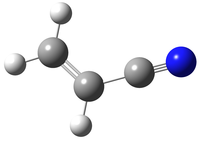Vinyl cyanide, propenenitrile, acrylonitrile, 15N isotopologue
 | |
|---|---|
| Species tag | 054509 |
| Version | 1* |
| Date of Entry | May 2008 |
| Contributor | H. S. P. Müller |
|
The spectroscopic parameters and the experimental
transition frequencies were published in | |
| Lines Listed | 11704 |
| Frequency / GHz | < 1200 |
| Max. J | 122 |
| log STR0 | -6.7 |
| log STR1 | -6.0 |
| Isotope Corr. | -2.4531 |
| Egy / cm–1 | 0.0 |
| µa / D | 3.815 |
| µb / D | 0.894 |
| µc / D | |
| A / MHz | 49655.9 |
| B / MHz | 4819.67 |
| C / MHz | 4387.05 |
| Q(300.0) | 27179.4508 |
| Q(225.0) | 17632.6433 |
| Q(150.0) | 9587.2701 |
| Q(75.00) | 3386.8457 |
| Q(37.50) | 1197.7787 |
| Q(18.75) | 424.1363 |
| Q(9.375) | 150.4952 |
| detected in ISM/CSM | no |